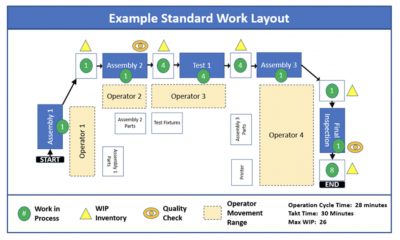
The new employee steps onto the production line, eager to get to work, when the old veteran says, “Just watch what I do. You will figure it out in no time.” The new employee watches the veteran work, quietly noting that others working in the area seem to be doing the same work in all sorts of different ways. What’s going on, here? What is the right way to do the job? What is the standard work?
An overview: What is standard work?
Standard work is a detailed representation and documentation of the most efficient method to produce a product or service as it is known today. It breaks down current state work into the elements and characteristics needed to understand and perform a process repeatedly. It’s one of the main tenets of lean manufacturing. Standard work is how you want your personnel to do the work — the same way every time.
Standard work includes many elements, including the key process steps, operator procedures, work locations, machinery or technology used, production sequencing, safety concerns, and quality checks. It also identifies the location and amount of inventory within the system. A standard work visual, also known as a standard work layout, depicts the general operator movement range and product flow path. It also includes information regarding operation cycle time and the takt time for the product.
When documented and presented in its totality, the standard work should demonstrate the desired properties of the work being performed. Documenting the standard work is important in keeping the system repeatable and predictable, as non-documented systems are more likely to deviate from the best practices for the process.
Below is an example of a standard work layout. Note the elements shown, and how with a quick glance, an observer can gain a lot of understanding as to the nature of the work without having any previous knowledge regarding the process.

3 benefits of attending to standard work
Standard work gives the user an improved understanding of how the work is being processed within an area. Its use helps reduce variability within the system, assists with faster training timeframes, and provides a starting point for process improvement projects.
1. Reduction in variability
By defining the best practices, and documenting the best practices, there is a means for getting all personnel involved to perform the work the same way every time. By performing the work the same way every time, you minimize your sources of errors and variability.
For example, if a product begins regularly failing a quality check at the end of the production line, a process using standard work means you have fewer places to look to find the root cause of the error. If the process is being performed three different ways by three different employees, who may be using three different tools to do the work, you now have nine different combinations of variables to consider.
This can get complex very quickly but is kept simpler if everyone is using the same instructions and same tools.
2. Faster training ramp-up periods
Investing in the creation of standard work instructions and layouts pays off well during training time for new personnel. It gives them material to use for understanding the best practices, speeding up the training process. On-the-job training via tribal knowledge, instead of standard work, lends to instructions being misunderstood or forgotten and longer training time periods.
Without standard work, employee frustrations are higher, which can lead to more mistakes made or losing the new employee. Standard work addresses many of the problems connected to tribal knowledge.
3. Information for process improvement projects
While standard work documents the best practices of the current state, it is not guaranteed that the process is the most efficient way to do the process. Standard work can be used as a baseline for project improvement projects, which always have the goal of looking for ways to do the work in less time, for less money, and with higher quality.
3 standard work best practices
1. When developing the standard work, it is paramount to be where the action happens when collecting your information. Just because an old instruction or computer system workflow says something happens does not mean it’s actually happening. Go see the people performing the work on a daily basis and verify that the standard work documentation being created does match reality.
2. Once standard work is understood, be sure to review aspects such as product flow, operator movements, and 5S organizational setup for your area. Do the products or operators travel unnecessary distances? Does the placement of tools and technology make sense? There are often improvements in flow and equipment placement that can be made very quickly, sometimes leading to low-cost, high-impact improvements.
3. Remember that the takt time shown can change over time with changing customer demands, so any standard work documentation showing takt time will need occasional updates.
Frequently Asked Questions (FAQ) about standard work
Is it difficult and expensive to create and maintain standard work?
If no standard work exists, it will take some commitment of labor resources to collect and document the standard work.
This sometimes scares away management, as they are concerned about committing the resources needed to create the standard work. They see the setup as a distraction to working on other problems, fighting for labor resources. It is important that management understands the power of using and maintaining standard work — and the money it will save in the long run.
Once documented, standard work will only require occasional updates and should not be cost prohibitive.
Are there challenges to applying standard work to an office environment?
Most of the key elements provided by standard work can easily be applied to an office environment. Performing the work the same way is particularly useful in an office environment when someone is absent, as another person can step in and know how to continue the work.
Priority of work must be well understood, as in many offices, one job is stopped halfway to start on a job with a higher priority, disrupting traditional flow. Order sizes may also vary more than a traditional manufacturing line. Lastly, takt time can potentially be very hard to balance and keep updated.
Do employees resent standard work?
As a whole, employees benefit from a documented standard work process. Such processes lead to lower stress due to confusing systems and provide methods to be successful, with clear goals and objectives.
There have been cases in history where standard work has been used in a way that dehumanizes personnel. Processes have been set up to be tightly efficient, but do not consider human needs, such as reasonable allowances for bathroom breaks or poor ergonomics. When standard work is used incorrectly, employees may feel they are being treated like robots instead of human beings.
Also, when trying to standardize, it may turn out that some employees are more proficient using different tools to do a job. The aim should be to determine the best tool for the job, then train up everyone to use that tool correctly. When working with people to use different tools, or making any changes, it is key to teach them why the change is being made, and why standardization means so much to the company’s success.
Standard work summary
Standard work is documentation that leads to an understanding of the work elements within the process. The information defines the best practices, allowing for repeatable and predictable work, improving efficiency. Being documented assists with making training ramp-up times shorter and serving as a baseline for future process improvement efforts.